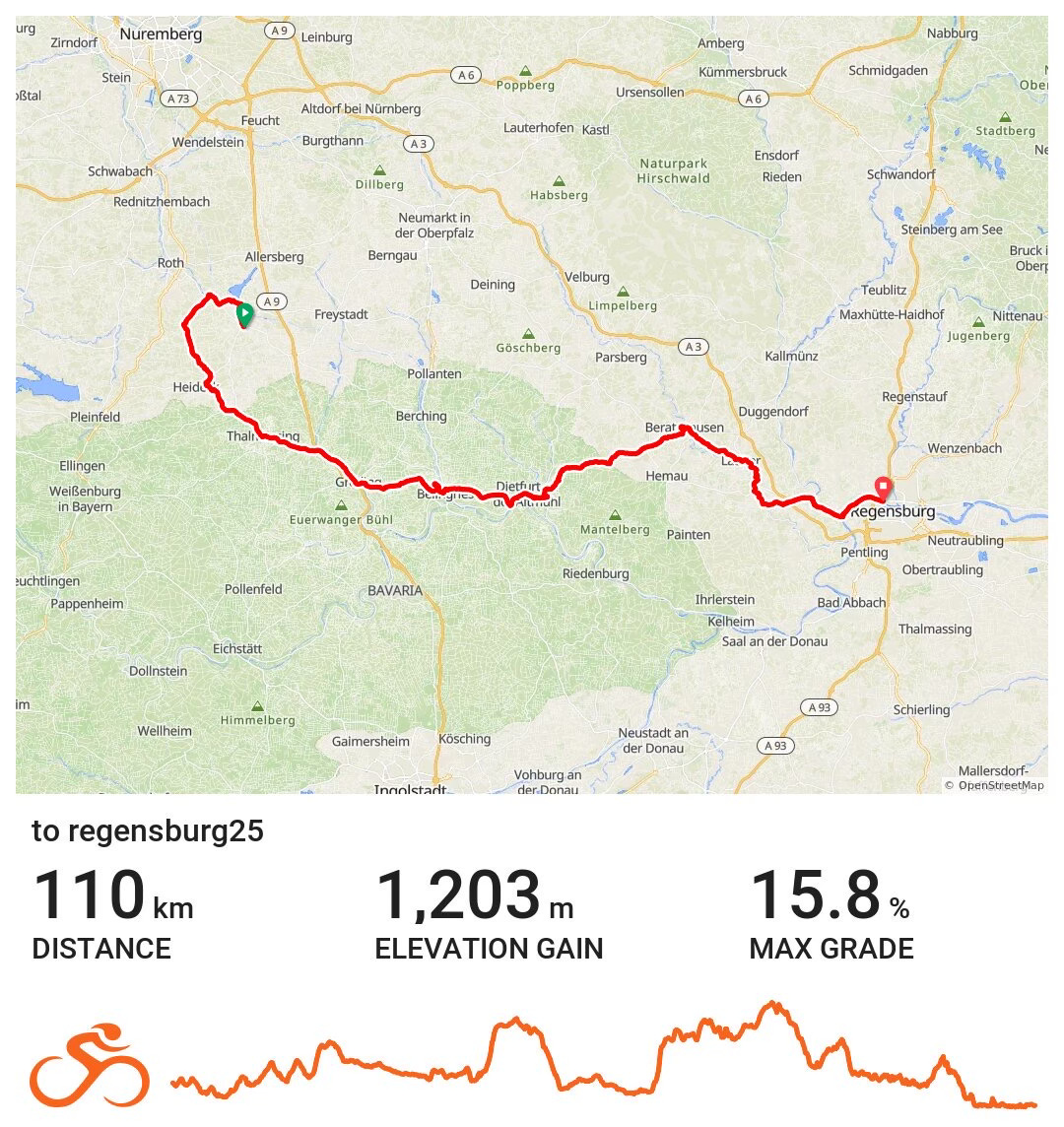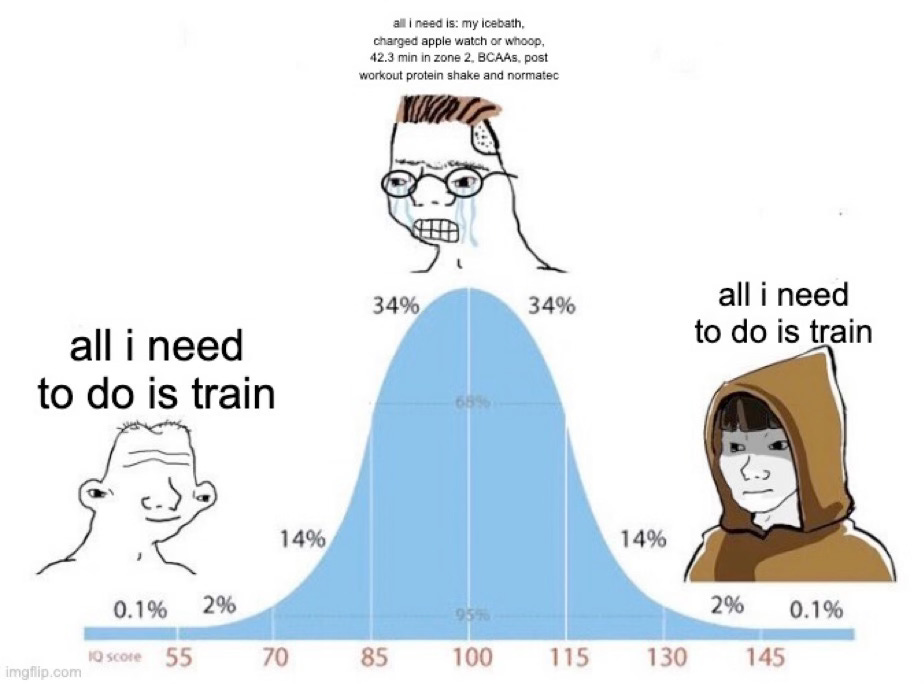I’ve cracked the code on living without AC.
Cool the room by having the windows open from midnight to 0800.
Seal it up and draw all curtains.
Point my mini-tower unit at me whenever inside.
Frequent cold showers so my body is an evaporative cooling unit.
Rather than shifting to a Spanish sleep schedule, I’ve been sleeping in two parts. Before, then after, midnight.
Shorter swim this morning then a 110 km rolling hills bike ride to Regensburg for a couple nights. My intention is to keep the ride endurance focused. We will see how well I do that in a group setting.
Beware Compliance Mindset
So far on camp, I’ve had this question four times so I’m guessing some of y’all might be wondering… Why does Gordo have a coach? I’ll answer generally, then more specifically.
There is a trap to be aware of in life (parenting, leadership, coaching)…
Be cautious with valuing compliance over progress.
The more insecurities we have, the greater the likelihood we will slide into a compliance mindset. A compliance mindset can lead to conflict when the team member (however, defined) becomes skilled. If you think about teens, then that’s part of what drives conflict. The teenager notices there’s a real person (with flaws) behind the curtain.
Same deal with coaching smart athletes (and we really want to work with smart people).
Same deal with outstanding associates in a training business (or any business).
Excellence Is Sticky
As a leader, you need to be thinking…
Why would my best people stay with me?
My answer is the subject of my True Wealth publication but there’s something deeper.
Mutual respect from shared experiences and a commitment to making incremental progress.
Excellence in a coaching-sense isn’t about winning, although it helps get new clients in the door.
Excellence is about the quality of the relationships and mutual respect. How might we make that happen:
Lots of case studies.
A commitment to continuous learning.
The building of a network of practitioners.
Documenting what works, and doesn’t.
A willingness to consider new approaches.
Have FUN with your people.
In sport, everyone who is decent knows both how to train and what works for them.
Not everyone knows:
What they are actually doing.
Why their approach is working.
What is not working.
Their blindspots.
Not everyone is willing to face their limitations, fears and blindspots.
That’s OK.
It’s our individual role to manage our OWN journey.1
That’s another trap.
Some approach coaches for validation to continue patterns of self-harm.
As a coach, if you fall into this pattern with athletes then it’s likely throughout your life (and intimate relationships). If it was a feature of your elite career, or younger life, then watch out. It’s likely still there.
Sometimes the best thing you can do for your athlete, and yourself, is to help them exit a situation. Competitive sport isn’t always a positive force.
In my own case, taking a long break from competition turned out great. I came back with fresh eyes and a willingness to try new methods. I saw the value of working with people who see the world differently than me.2
Specifics About Me
If you want one of the smartest minds in your sport to follow your program closely then you’ll need to compensate them for their time.
Even if you offer to pay a lot of money… they might not be willing to do it. So your first challenge is building a relationship with someone really smart3. This applies both ways. Great athletes want to work with great people.
The above is related to performance but I’m using great in a sense of goodness, high quality and integrity. If someone works with me then they know I am going to rub off on them. They see that as a good thing.
How do you leverage your coach while building your own plan?
More than 95% of my plan is showing up. The magic is work over time. The compounding effect of 30-years of better habits.
The meme contains a deep truth about performance, and coaching.
To the guy in the middle (mid pack), it seems silly to hire a coach for 3% of his program.
To the guy on the left (novice), he needs a simple, basic week to repeat.
To the elite/top amateur, the 3% is worth it, and necessary, to get the most out of his performance.
The goal of the experienced coach, and experienced athlete, is to figure out (together) what the 3% is. It’s discovered via listening and having the ability to ask the right questions of each other. I’m better at asking questions than listening. I write myself a note (to listen) before all my meetings.
Put this another way…
The guy on the left has no ability to assess the plan.
The guy in the middle thinks he’s buying a plan.
The guy on the right knows he’s paying for share of mind.
How has your role as a coached athlete evolved over the years, perhaps from following a plan to a T that is given to you vs. now self (or co-) programming with coach oversight?
Following a plan to a T is inferior for my goals.4
That was the #1 thing I discovered with my return to sport. Dynamic loading, based on stress management, is a material advance. This is where I have an edge. I combine domain-specific knowledge with self-awareness. Great coaches, who see their athletes daily, have known this forever.
It’s also a liability for the remote coach. How to adjust the plan without seeing the athlete all the time? We can follow metrics, build readiness scores, but they don’t work as well as watching someone perform and interact with others.
To do it right is a large emotional and time investment.
Swim went great.
Time to ride.
Endurance Essentials eBook page
It’s never my role to fix anyone other than myself.
Diversity of thought is more powerful than the skin deep definition used in the West.
Treasure your relationships with the best people you come across. I will travel long distances and/or inconvenience myself to have fun with people I deeply respect. I am willing to go-to-them to keep myself in their mind.
I used to be able to tell you exactly what I would be doing for the following two weeks and, if it was on the schedule then it was getting done. My inflexibility and lack of an effective adaptation strategy cost me significant performance.
Where in your life does inflexibility and old patterns cost you?








Great share. The longer I coach, the more I see myself as bumpers in a bowling lane. The athlete still has to roll the ball, but I prevent them from going in the gutters. In addition, it can’t be a hierarchical relationship, but one that has regular feedback and communication from both people—a team or partnership.